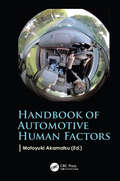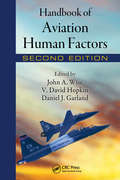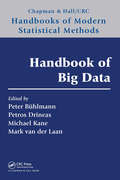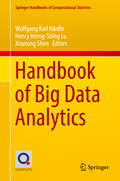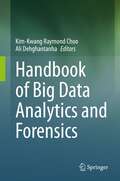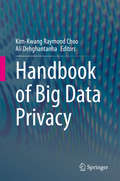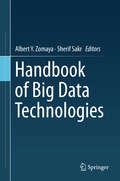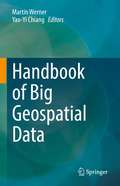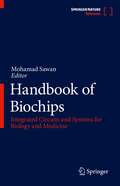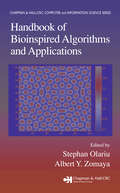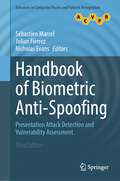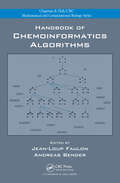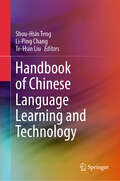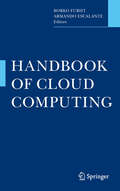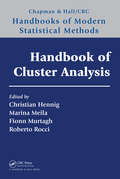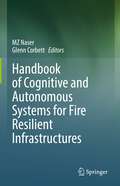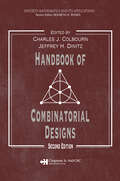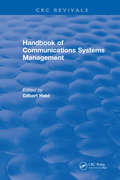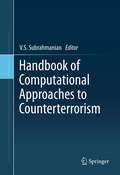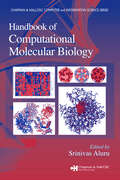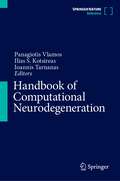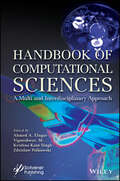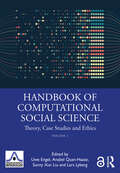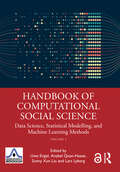- Table View
- List View
Handbook of Automotive Human Factors
by Motoyuki AkamatsuThanks to advances in computer technology in the last twenty years, navigation system, cabin environment control, ACC, advanced driver assistance system (ADAS) and automated driving have become a part of the automobile experience. Improvement in technology enables us to design these with greater flexibility and provide greater value to the driver (human centered design). To achieve this, research is required by laboratories, automobile and auto parts manufacturers. Although there has been a lot of effort in human factors research and development, starting from basic research to product development, the knowledge and experience has not been integrated optimally. <p><P>The aim of this book is to collect and review the information for researchers, designers and developers to learn and apply them for further research and development of human centered design of future automotive technologies. Automotive human factors include psychological, physiological, mathematical, engineering and even sociological aspects. This book offers valuable insights to applying the right approach in the right place.
Handbook of Aviation Human Factors
by John A. Wise Daniel J. Garland V. David HopkinA complete examination of issues and concepts relating to human factors in simulation, this book covers theory and application in space, ships, submarines, naval aviation, and commercial aviation. The authors examine issues of simulation and their effect on the validity and functionality of simulators as a training device. The chapters contain in d
Handbook of Big Data (Chapman & Hall/CRC Handbooks of Modern Statistical Methods)
by Michael Kane Peter Bühlmann Petros Drineas Mark van der LaanHandbook of Big Data provides a state-of-the-art overview of the analysis of large-scale datasets. Featuring contributions from well-known experts in statistics and computer science, this handbook presents a carefully curated collection of techniques from both industry and academia. Thus, the text instills a working understanding of key statistical
Handbook of Big Data Analytics (Springer Handbooks Of Computational Statistics Ser.)
by Wolfgang Karl Härdle Henry Horng-Shing Lu Xiaotong ShenAddressing a broad range of big data analytics in cross-disciplinary applications, this essential handbook focuses on the statistical prospects offered by recent developments in this field. To do so, it covers statistical methods for high-dimensional problems, algorithmic designs, computation tools, analysis flows and the software-hardware co-designs that are needed to support insightful discoveries from big data. The book is primarily intended for statisticians, computer experts, engineers and application developers interested in using big data analytics with statistics. Readers should have a solid background in statistics and computer science.
Handbook of Big Data Analytics and Forensics
by Kim-Kwang Raymond Choo Ali DehghantanhaThis handbook discusses challenges and limitations in existing solutions, and presents state-of-the-art advances from both academia and industry, in big data analytics and digital forensics. The second chapter comprehensively reviews IoT security, privacy, and forensics literature, focusing on IoT and unmanned aerial vehicles (UAVs). The authors propose a deep learning-based approach to process cloud’s log data and mitigate enumeration attacks in the third chapter. The fourth chapter proposes a robust fuzzy learning model to protect IT-based infrastructure against advanced persistent threat (APT) campaigns. Advanced and fair clustering approach for industrial data, which is capable of training with huge volume of data in a close to linear time is introduced in the fifth chapter, as well as offering an adaptive deep learning model to detect cyberattacks targeting cyber physical systems (CPS) covered in the sixth chapter. The authors evaluate the performance of unsupervised machine learning for detecting cyberattacks against industrial control systems (ICS) in chapter 7, and the next chapter presents a robust fuzzy Bayesian approach for ICS’s cyber threat hunting. This handbook also evaluates the performance of supervised machine learning methods in identifying cyberattacks against CPS. The performance of a scalable clustering algorithm for CPS’s cyber threat hunting and the usefulness of machine learning algorithms for MacOS malware detection are respectively evaluated.This handbook continues with evaluating the performance of various machine learning techniques to detect the Internet of Things malware. The authors demonstrate how MacOSX cyberattacks can be detected using state-of-the-art machine learning models. In order to identify credit card frauds, the fifteenth chapter introduces a hybrid model. In the sixteenth chapter, the editors propose a model that leverages natural language processing techniques for generating a mapping between APT-related reports and cyber kill chain. A deep learning-based approach to detect ransomware is introduced, as well as a proposed clustering approach to detect IoT malware in the last two chapters.This handbook primarily targets professionals and scientists working in Big Data, Digital Forensics, Machine Learning, Cyber Security Cyber Threat Analytics and Cyber Threat Hunting as a reference book. Advanced level-students and researchers studying and working in Computer systems, Computer networks and Artificial intelligence will also find this reference useful.
Handbook of Big Data Privacy
by Kim-Kwang Raymond Choo Ali DehghantanhaThis handbook provides comprehensive knowledge and includes an overview of the current state-of-the-art of Big Data Privacy, with chapters written by international world leaders from academia and industry working in this field. The first part of this book offers a review of security challenges in critical infrastructure and offers methods that utilize acritical intelligence (AI) techniques to overcome those issues. It then focuses on big data security and privacy issues in relation to developments in the Industry 4.0. Internet of Things (IoT) devices are becoming a major source of security and privacy concern in big data platforms. Multiple solutions that leverage machine learning for addressing security and privacy issues in IoT environments are also discussed this handbook. The second part of this handbook is focused on privacy and security issues in different layers of big data systems. It discusses about methods for evaluating security and privacy of big data systems on network, application and physical layers. This handbook elaborates on existing methods to use data analytic and AI techniques at different layers of big data platforms to identify privacy and security attacks. The final part of this handbook is focused on analyzing cyber threats applicable to the big data environments. It offers an in-depth review of attacks applicable to big data platforms in smart grids, smart farming, FinTech, and health sectors. Multiple solutions are presented to detect, prevent and analyze cyber-attacks and assess the impact of malicious payloads to those environments. This handbook provides information for security and privacy experts in most areas of big data including; FinTech, Industry 4.0, Internet of Things, Smart Grids, Smart Farming and more. Experts working in big data, privacy, security, forensics, malware analysis, machine learning and data analysts will find this handbook useful as a reference. Researchers and advanced-level computer science students focused on computer systems, Internet of Things, Smart Grid, Smart Farming, Industry 4.0 and network analysts will also find this handbook useful as a reference.
Handbook of Big Data Technologies
by Albert Y. Zomaya Sherif SakrThis handbook offers comprehensive coverage of recent advancements in Big Data technologies and related paradigms. Chapters are authored by international leading experts in the field, and have been reviewed and revised for maximum reader value. The volume consists of twenty-five chapters organized into four main parts. Part one covers the fundamental concepts of Big Data technologies including data curation mechanisms, data models, storage models, programming models and programming platforms. It also dives into the details of implementing Big SQL query engines and big stream processing systems. Part Two focuses on the semantic aspects of Big Data management including data integration and exploratory ad hoc analysis in addition to structured querying and pattern matching techniques. Part Three presents a comprehensive overview of large scale graph processing. It covers the most recent research in large scale graph processing platforms, introducing several scalable graph querying and mining mechanisms in domains such as social networks. Part Four details novel applications that have been made possible by the rapid emergence of Big Data technologies such as Internet-of-Things (IOT), Cognitive Computing and SCADA Systems. All parts of the book discuss open research problems, including potential opportunities, that have arisen from the rapid progress of Big Data technologies and the associated increasing requirements of application domains. Designed for researchers, IT professionals and graduate students, this book is a timely contribution to the growing Big Data field. Big Data has been recognized as one of leading emerging technologies that will have a major contribution and impact on the various fields of science and varies aspect of the human society over the coming decades. Therefore, the content in this book will be an essential tool to help readers understand the development and future of the field.
Handbook of Big Geospatial Data
by Martin Werner Yao-Yi ChiangThis handbook covers a wide range of topics related to the collection, processing, analysis, and use of geospatial data in their various forms. This handbook provides an overview of how spatial computing technologies for big data can be organized and implemented to solve real-world problems. Diverse subdomains ranging from indoor mapping and navigation over trajectory computing to earth observation from space, are also present in this handbook. It combines fundamental contributions focusing on spatio-textual analysis, uncertain databases, and spatial statistics with application examples such as road network detection or colocation detection using GPUs. In summary, this handbook gives an essential introduction and overview of the rich field of spatial information science and big geospatial data. It introduces three different perspectives, which together define the field of big geospatial data: a societal, governmental, and governance perspective. It discusses questions of how the acquisition, distribution and exploitation of big geospatial data must be organized both on the scale of companies and countries. A second perspective is a theory-oriented set of contributions on arbitrary spatial data with contributions introducing into the exciting field of spatial statistics or into uncertain databases. A third perspective is taking a very practical perspective to big geospatial data, ranging from chapters that describe how big geospatial data infrastructures can be implemented and how specific applications can be implemented on top of big geospatial data. This would include for example, research in historic map data, road network extraction, damage estimation from remote sensing imagery, or the analysis of spatio-textual collections and social media. This multi-disciplinary approach makes the book unique.This handbook can be used as a reference for undergraduate students, graduate students and researchers focused on big geospatial data. Professionals can use this book, as well as practitioners facing big collections of geospatial data.
Handbook of Biochips: Integrated Circuits and Systems for Biology and Medicine
by Mohamad SawanThis book provides a broad survey of the field of biochips, including fundamentals of microelectronics and biomaterials interaction with various, living tissues, as well as numerous, diverse applications. Although a wide variety of biochips will be described, there will be a focus on those at the brain-machine interface. Analysis is included of the relationship between different categories of biochips and their interactions with the body and coverage includes wireless remote control of biochips and arrays of microelectrodes, based on new biomaterials.
Handbook of Bioinspired Algorithms and Applications
by Albert Y. Zomaya Stephan OlariuThe mystique of biologically inspired (or bioinspired) paradigms is their ability to describe and solve complex relationships from intrinsically very simple initial conditions and with little or no knowledge of the search space. Edited by two prominent, well-respected researchers, the Handbook of Bioinspired Algorithms and Applications reveals the
Handbook of Biometric Anti-Spoofing: Presentation Attack Detection and Vulnerability Assessment (Advances in Computer Vision and Pattern Recognition)
by Nicholas Evans Sébastien Marcel Julian FierrezThe third edition of this authoritative and comprehensive handbook is the definitive work on the current state of the art of Biometric Presentation Attack Detection (PAD) – also known as Biometric Anti-Spoofing. Building on the success of the previous editions, this thoroughly updated third edition has been considerably revised to provide even greater coverage of PAD methods, spanning biometrics systems based on face, fingerprint, iris, voice, vein, and signature recognition. New material is also included on major PAD competitions, important databases for research, and on the impact of recent international legislation. Valuable insights are supplied by a selection of leading experts in the field, complete with results from reproducible research, supported by source code and further information available at an associated website.Topics and features: reviews the latest developments in PAD for fingerprint biometrics, covering recent technologies like Vision Transformers, and review of competition series; examines methods for PAD in iris recognition systems, the use of pupil size measurement or multiple spectra for this purpose; discusses advancements in PAD methods for face recognition-based biometrics, such as recent progress on detection of 3D facial masks and the use of multiple spectra with Deep Neural Networks; presents an analysis of PAD for automatic speaker recognition (ASV), including a study of the generalization to unseen attacks; describes the results yielded by key competitions on fingerprint liveness detection, iris liveness detection, and face anti-spoofing; provides analyses of PAD in finger-vein recognition, in signature biometrics, and in mobile biometrics; includes coverage of international standards in PAD and legal aspects of image manipulations like morphing.This text/reference is essential reading for anyone involved in biometric identity verification, be they students, researchers, practitioners, engineers, or technology consultants. Those new to the field will also benefit from a number of introductory chapters, outlining the basics for the most important biometrics.This text/reference is essential reading for anyone involved in biometric identity verification, be they students, researchers, practitioners, engineers, or technology consultants. Those new to the field will also benefit from a number of introductory chapters, outlining the basics for the most important biometrics.
Handbook of Cell Biosensors
by Sylvia Daunert Shimshon Belkin Sylvain Martel Paul Freemont Julie Hermans Isao Karube Elisa Michelini Aldo RodaThis handbook is an interdisciplinary and comprehensive reference covering all aspects of cell biosensors. It is divided into four main sections which are led and organized by numerous international experts. The scope of coverage includes: Fundamentals and genetics for biosensor applicationsTransducers, Materials and SystemsMarkets, innovation and educationApplication of biosensors in business Biosensor research is an exciting hybrid world where biologists, chemists, physicists, engineers and computer engineers come together. This handbook will serve as an invaluable living resource for all researchers in academia and industry working with cell biosensors.
Handbook of Chemoinformatics Algorithms (Chapman & Hall/CRC Computational Biology Series)
by Jean-Loup Faulon Andreas BenderUnlike in the related area of bioinformatics, few books currently exist that document the techniques, tools, and algorithms of chemoinformatics. Bringing together worldwide experts in the field, the Handbook of Chemoinformatics Algorithms provides an overview of the most common chemoinformatics algorithms in a single source.After a historical persp
Handbook of Chinese Language Learning and Technology
by Shou-Hsin Teng Li-Ping Chang Te-Hsin LiuThis handbook explores quantitative linguistics, pedagogy, and Mandarin language acquisition in an integrated fashion and helps readers grasp how insights from quantitative linguistics can shed light on Mandarin language acquisition. It focuses on issues related to language processing, learning, and teaching and how these aspects are affected or enhanced by corpus-based and computational linguistics. By following a data-driven approach, the handbook demonstrates how theoretical problems in the acquisition of Chinese can be resolved with empirical evidence. The book serves as an essential resource for students and researchers wishing to explore the fascinating field of Chinese language processing and acquisition.
Handbook of Cloud Computing
by Borko Furht Armando EscalanteCloud computing has become a significant technology trend. Experts believe cloud computing is currently reshaping information technology and the IT marketplace. The advantages of using cloud computing include cost savings, speed to market, access to greater computing resources, high availability, and scalability. Handbook of Cloud Computing includes contributions from world experts in the field of cloud computing from academia, research laboratories and private industry. This book presents the systems, tools, and services of the leading providers of cloud computing; including Google, Yahoo, Amazon, IBM, and Microsoft. The basic concepts of cloud computing and cloud computing applications are also introduced. Current and future technologies applied in cloud computing are also discussed. Case studies, examples, and exercises are provided throughout. Handbook of Cloud Computing is intended for advanced-level students and researchers in computer science and electrical engineering as a reference book. This handbook is also beneficial to computer and system infrastructure designers, developers, business managers, entrepreneurs and investors within the cloud computing related industry.
Handbook of Cluster Analysis (Chapman & Hall/CRC Handbooks of Modern Statistical Methods)
by Fionn Murtagh Marina Meila Roberto Rocci Christian HennigHandbook of Cluster Analysis provides a comprehensive and unified account of the main research developments in cluster analysis. Written by active, distinguished researchers in this area, the book helps readers make informed choices of the most suitable clustering approach for their problem and make better use of existing cluster analysis tools.The
Handbook of Cognitive and Autonomous Systems for Fire Resilient Infrastructures
by Glenn Corbett Mz NaserThis handbook aims at modernizing the current state of civil engineering and firefighting, especially in this era where infrastructures are reaching new heights, serving diverse populations, and being challenged by unique threats. Its aim is to set the stage toward realizing contemporary, smart, and resilient infrastructure.The Handbook of Cognitive and Autonomous Systems for Fire Resilient Infrastructures draws convergence between civil engineering and firefighting to the modern realm of interdisciplinary sciences (i.e., artificial intelligence, IoT, robotics, sensing, and human psychology). As such, this work aims to revolutionize the current philosophy of design for one of the most notorious extreme events: fire. Unlike other publications, which are narrowed to one specific research area, this handbook cultivates a paradigm in which critical aspects of structural design, technology, and human behavior are studied and examined through chapters written by leaders in their fields. This handbook can also serve as a textbook for graduate and senior undergraduate students in Civil, Mechanical, and Fire Protection engineering programs as well as for students in Architectural and social science disciplines. Students, engineers, academics, professionals, scientists, firefighters, and government officials involved in national and international societies such as the American Society of Civil Engineers (ASCE), Society of Fire Protection Engineers (SFPE), National Fire Protection Association (NFPA), and Institute of Electrical and Electronics Engineers (IEEE), among others, will benefit from this handbook.
Handbook of Combinatorial Designs (Discrete Mathematics and Its Applications)
by Charles J. Colbourn Jeffrey H. DinitzContinuing in the bestselling, informative tradition of the first edition, the Handbook of Combinatorial Designs, Second Edition remains the only resource to contain all of the most important results and tables in the field of combinatorial design. This handbook covers the constructions, properties, and applications of designs as well as existence
Handbook of Communications Systems Management: 1999 Edition
by Gilbert HeldAs a manager of the �90s, you know that IT departments like your own must continue to meet increasingly sophisticated end-user needs despite highly limited resources. Learn when it�s best to farm out work to consultants, when to reserve internal resources for other tasks, and how best to use your in-house staff. Coverage unlike any other in the marketplace. Written by 41 experts � all practitioners in the networking and IS management fields � this guidebook provides unique depth and scope. In this Third Edition, you�ll find all new material that clearly outlines today�s hottest issues. Prepares you to quickly respond to management requirements. Are you aware of the latest on strategic planning, systems planning, and points-of-failure planning? Have you linked your IT architecture and business plans? Have you updated senior management as to how IT can help achieve corporate goals? Do you have a corporate technology plan? Turn to the Handbook for all this and more. Now you can get up to speed on the latest in client/server, on how to give your end users faster and greater access to corporate data at a lower cost, and on how to quantify the amount of network support that this improvement will require? The Handbook was written with you in mind. The perfect resource for today�s successful communications systems manager. This comprehensive, highly authoritative reference is designed to help you select, maintain, and manage your communications systems. It provides all the tools you need to evaluate, formulate, and implement effective communications network strategies to keep pace with today�s rapidly changing technology. You get illustrations, tables, and diagrams to clearly outline and guide you the entire way. Be aware of the latest technologies and their impact on you. Keep costs down by aiding your thinking through all the systems and network elements from concept through implementation and day-to-day operation.
Handbook of Computational Approaches to Counterterrorism
by V. S. SubrahmanianTerrorist groups throughout the world have been studied primarily through the use of social science methods. However, major advances in IT during the past decade have led to significant new ways of studying terrorist groups, making forecasts, learning models of their behaviour, and shaping policies about their behaviour. Handbook of Computational Approaches to Counterterrorism provides the first in-depth look at how advanced mathematics and modern computing technology is shaping the study of terrorist groups. This book includes contributions from world experts in the field, and presents extensive information on terrorism data sets, new ways of building such data sets in real-time using text analytics, introduces the mathematics and computational approaches to understand terror group behaviour, analyzes terror networks, forecasts terror group behaviour, and shapes policies against terrorist groups. Auxiliary information will be posted on the book's website. This book targets defence analysts, counter terror analysts, computer scientists, mathematicians, political scientists, psychologists, and researchers from the wide variety of fields engaged in counter-terrorism research. Advanced-level students in computer science, mathematics and social sciences will also find this book useful.
Handbook of Computational Molecular Biology (Chapman & Hall/CRC Computer and Information Science Series)
by Srinivas AluruThe enormous complexity of biological systems at the molecular level must be answered with powerful computational methods. Computational biology is a young field, but has seen rapid growth and advancement over the past few decades. Surveying the progress made in this multidisciplinary field, the Handbook of Computational Molecular Biology of
Handbook of Computational Neurodegeneration
by Ilias S. Kotsireas Panagiotis Vlamos Ioannis TarnanasThe Handbook of Computational Neurodegeneration provides a comprehensive overview of the field and thus bridges the gap between standard textbooks of research on neurodegeneration and dispersed publications for specialists that have a narrowed focus on computational methods to study this complicated process. The handbook reviews the central issues and methodological approaches related to the field for which the reader pursues a thorough overview. It also conveys more advanced knowledge, thus serving both as an introductory text and as a starting point for an in-depth study of a specific area, as well as a quick reference source for the expert by reflecting the state of the art and future prospects. The book includes topics that are usually missing in standard textbooks and that are only marginally represented in the specific literature. The broad scope of this handbook is reflected by five major parts that facilitate an integration of computational concepts, methods and applications in the study of neurodegeneration. Each part is intended to stand on its own, giving an overview of the topic and the most important problems and approaches, which are supported by examples, practical applications, and proposed methodologies. The basic concepts and knowledge, standard procedures and methods are presented, as well as recent advances and new perspectives.
Handbook of Computational Sciences: A Multi and Interdisciplinary Approach
by Krishna Kant Singh Zdzislaw Polkowski Ahmed A. Elgnar Vigneshwar MThe Handbook of Computational Sciences is a comprehensive collection of research chapters that brings together the latest advances and trends in computational sciences and addresses the interdisciplinary nature of computational sciences, which require expertise from multiple disciplines to solve complex problems. This edited volume covers a broad range of topics, including computational physics, chemistry, biology, engineering, finance, and social sciences. Each chapter provides an in-depth discussion of the state-of-the-art techniques and methodologies used in the respective field. The book also highlights the challenges and opportunities for future research in these areas. The volume pertains to applications in the areas of imaging, medical imaging, wireless and WS networks, IoT with applied areas, big data for various applicable solutions, etc. This text delves deeply into the core subject and then broadens to encompass the interlinking, interdisciplinary, and cross-disciplinary sections of other relevant areas. Those areas include applied, simulation, modeling, real-time, research applications, and more. Audience Because of the book’s multidisciplinary approach, it will be of value to many researchers and engineers in different fields including computational biologists, computational chemists, and physicists, as well as those in life sciences, neuroscience, mathematics, and software engineering.
Handbook of Computational Social Science, Volume 1: Theory, Case Studies and Ethics (European Association of Methodology Series)
by Lars Lyberg Uwe Engel Anabel Quan-Haase Sunny Xun LiuThe Handbook of Computational Social Science is a comprehensive reference source for scholars across multiple disciplines. It outlines key debates in the field, showcasing novel statistical modeling and machine learning methods, and draws from specific case studies to demonstrate the opportunities and challenges in CSS approaches. The Handbook is divided into two volumes written by outstanding, internationally renowned scholars in the field. This first volume focuses on the scope of computational social science, ethics, and case studies. It covers a range of key issues, including open science, formal modeling, and the social and behavioral sciences. This volume explores major debates, introduces digital trace data, reviews the changing survey landscape, and presents novel examples of computational social science research on sensing social interaction, social robots, bots, sentiment, manipulation, and extremism in social media. The volume not only makes major contributions to the consolidation of this growing research field but also encourages growth in new directions. With its broad coverage of perspectives (theoretical, methodological, computational), international scope, and interdisciplinary approach, this important resource is integral reading for advanced undergraduates, postgraduates, and researchers engaging with computational methods across the social sciences, as well as those within the scientifi c and engineering sectors.
Handbook of Computational Social Science, Volume 2: Data Science, Statistical Modelling, and Machine Learning Methods (European Association of Methodology Series)
by Lars Lyberg Uwe Engel Anabel Quan-Haase Sunny Xun LiuThe Handbook of Computational Social Science is a comprehensive reference source for scholars across multiple disciplines. It outlines key debates in the field, showcasing novel statistical modeling and machine learning methods, and draws from specific case studies to demonstrate the opportunities and challenges in CSS approaches. The Handbook is divided into two volumes written by outstanding, internationally renowned scholars in the field. This second volume focuses on foundations and advances in data science, statistical modeling, and machine learning. It covers a range of key issues, including the management of big data in terms of record linkage, streaming, and missing data. Machine learning, agent-based and statistical modeling, as well as data quality in relation to digital trace and textual data, as well as probability, non-probability, and crowdsourced samples represent further foci. The volume not only makes major contributions to the consolidation of this growing research field, but also encourages growth into new directions. With its broad coverage of perspectives (theoretical, methodological, computational), international scope, and interdisciplinary approach, this important resource is integral reading for advanced undergraduates, postgraduates, and researchers engaging with computational methods across the social sciences, as well as those within the scientific and engineering sectors.
